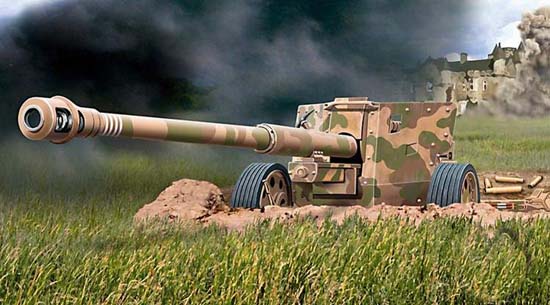


Pak 43/ 41 Draguignan
English Translation
 |
Durant la deuxième guerre mondiale les allemands avaient une arme terrible pour arrêter et détruire les chars. Cette arme avait pour nom le canon de 88.
Le canon de 88 est l'arme anti aérienne et anti char la plus connue au monde. Son origine date des années 1920 .Elle est elle même issue d'un programme de la première guerre mondiale qui avait pour nom canon anti aérien flak 18. En 1930 de la silhouette de ce canon est figée.
Affectée à la Wehrmacht et à la Luftwaffe, cette arme a servi durant la guerre d'Espagne comme arme anti-aérienne. La légende veut que durant cette guerre civile les troupes allemandes de la Légion Condor aient utilisé les canons de 88 pour enrayer une offensive des chars républicains.
Au début de la guerre de 39/45 cette arme a été utilisée aussi bien en anti char comme arme anti aérienne. C'était l'arme polyvalente par excellence de l'armée allemande.
Le canon de Flak 18, laissa la place aux Flak 36 /37. Face au succès de cette formule les ingénieurs allemands décidèrent de créer une famille d'armes autour de cette pièce. Les études furent poussées plus avant sous le nom de Gërat 42. Ayant constaté que la puissance de l’arme arrivait à ses limites, les ingénieurs allemands décidèrent d'améliorer celle ci. La firme développa donc un nouveau canon anti char sous le nom de PaK 43 qui était une arme puissante mais aussi imposante.
Elle nécessitait l'utilisation d'un tracteur lourd pour tout déplacement. Face à la demande de pièces anti chars il fut donc décidé d'améliorer ce canon pour le rendre plus mobile Ainsi naquit le canon de PaK 43/41 qui est en fait un assemblage de divers éléments provenant de diverses pièces.
Il fut baptisé Sheunentor ou porte de grange. Le canon est monté sur un affût de flèche extrapolé de l'obusier 1e F H 18 de 105 mm. Le train de roulement provient du canon sFH 18 de 150 mm. Par la suite ce canon fut monté sur le Tigre II.
Les munitions de cette arme étaient différentes des munitions anti aérienne et surtout beaucoup plus puissantes.
.jpg) |
| Merci Vincent |
Caractéristiques de l'arme.
Calibre 8 8mm
Longueur. 6.61 m
longueur du tube 5.126m
Poids en ordre de marche. 4.715 kgs
Pointage Azimut - 8 + 40, site 360°
V/O obus perforant 1.130 m/ seconde Obus explosifs 952 m/ seconde
Poids du projectile perforant 10 kg explosif 9.5 kg
Puissance de pénétration 184 mm/ a 2000 m Portée maximum 15 Km
Autres photoscopes Others Walk Around Voir ICI 1 2 3
 |
.jpg) |
| Merci Vincent |